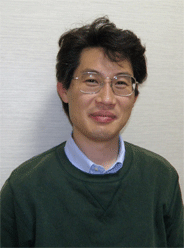
Office Address Department of Earth Science & Astronomy, Graduate School of Arts and Sciences, The University of Tokyo, 3-8-1 Komaba, Meguro, TOKYO 153-8902, JAPAN
Telephone +81 (0)3-5454-6609
Facsimile +81 (0)3-5465-8244
E-mail komiya@ea.c.u-tokyo.ac.jp
Homepage http://ea.c.u-tokyo.ac.jp/earth/Members/komiya.html
Sex MALE
Date of Birth 23 February 1972
Place of Birth Sumida-ku, Tokyo, JAPAN
Nationality Japanese
EDUCATION AND QUALIFICATIONS
1987-1990: Ryogoku high school, Sumida-ku, Tokyo
1990-1994: Dept. of Applied physics, Faculty of Science, Tokyo Institute of Technology (B.Sc.)
1994-1996: Course of Applied physics, Graduate school of Science and Technology, Tokyo Institute of Technology (M.Sc.)
1996-1999: Course of Applied physics, Graduate school of Science and Technology, Tokyo Institute of Technology
(Ph.D. The secular variation of the composition and temperature of MORB-source mantle)
EMPLOYMENT
1999-2000: RIKEN Senior Researcher Fellow at Tokyo Institute of Technology, Tokyo, Japan. Project: Global material circulation:
Evidence from mantle xenoliths in kimberlite and related rocks.
2000-2003: Research Fellow of the Japan Society for the Promotion of Science at Tokyo Institute of Technology, Tokyo, Japan.
2003-2003: Research Fellow of the Interactive Research Center of Science at Tokyo Institute of Technology, Tokyo, Japan.
2003-2006: Assistant Professor, Interactive Research Center of Science, Graduate School of Science and Engineering,
Tokyo Institute of Technology, Tokyo, Japan.
2006-2009: Associate Professor, Department of Earth and Planetary Sciences, Graduate School of Science and Engineering,
Tokyo Institute of Technology, Tokyo, Japan.
2009- Associate Professor, Department of Earth Science and Astronomy Graduate School of Arts and Sciences,
The University of Tokyo, Tokyo, Japan.
OTHERS
2008 (Nov)-2009 (Sep): Visiting Scientist, Arizona State University
AWARDS & HONORS
Yoshiaki Ozawa Medal (Paleontology and stratigraphy), Geological Society of Japan 2009
LIST OF MAJOR PUBLICATIONS
[1] Komiya, T., Maruyama, S., Nohda, S., Masuda, T., Hayashi, M. & Okamoto, S., 1999, Plate tectonics at 3.8 – 3.7 Ga; Field evidence from the Isua accretionary complex, southern West Greenland. Jour. Geol., 107, 515-554.
[2] Komiya, T., 2004, Material circulation model including chemical differentiation within the mantle and secular variation of temperature and composition of the mantle. Physics of the Earth and Planetary Interiors, 146, 333-367.
[3] Komiya, T., Hirata, T., Kitajima, K., Yamamoto, S., Shibuya, T., Sawaki, Y., Ishikawa, T., Shu, D., Li, Y., Han, J., 2008. Evolution of the composition of seawater through geologic time, and its influence on the evolution of life Gondwana Research, 14, 159-174.
My interest is history of Earth: evolution of solid earth (e.g. initiation of plate tectonics), environmental change (e.g. seawater composition) and evolution of life through geologic time. Recently, we try to decode environmental change, which includes surface temperature, seawater composition (redox-sensitive elements and nutrients) and global carbon cycle, after the Marinoan (630 Ma) Snowball Earth to early Cambrian based on multi-isotopic and elemental analyses (proxies) of sedimentary rocks, and the influence of environmental change on the drastic evolution of life (emergence of multicellular animals, Ediacara Fauna and Metazoan around 600 Ma and Cambrian shelly biota.)
2006- : Role of surface environmental change on emergence of animals
We carried out on-land drilling programs at three sites in Three Gorge area and collected almost complete sedimentary succession from 635 Ma Marinoan Snowball earth tillite to Early Cambrian. We made a detailed chemostratigraphies of delta13C, delta18O, 87Sr/86Sr, 88Sr/86Sr (delta88Sr) and 44Ca/42Ca (delta44/42Ca), and Fe, Mn P contents of carbonate rocks and delta13C of organic carbon t decode surface environmental change and its role on biological evolution. The synchronousness of emergence of Metazoan, Ediacaran Fauna and metazoan with hard skeleton and the 87Sr/86Sr positive anomaly also suggests that the appearance of the animals was caused by increase of continental weathering. In addition, the 87Sr/86Sr positive anomaly corresponds to global cooling and global warming. Enhancement of nutrients in seawater caused sudden and distinguished biological evolution instead of increase of oxygen content of seawater. In addition, the deficiency of oxygen in the seawater expands the stability field of some nutrients like P, Ca, and Fe in the seawater promoted emergence of metazoans.
2003-2006: Decoding of surface environmental history
Proposal of mantle dynamics through the time based on secular change of mantle temperature, subduction zone and high pressure experiments (Komiya, 2007). Quantitative estimate of oxygen content in seawater through geologic time based on In-situ analyses of REEs concentrations in carbonate minerals from 3.5 billion years ago, namely the Middle Archean, with LA-ICP-MS and thermodynamic calculation. We found that oxygen content of seawater increased since 2.7 billion years ago, but frequently decreased, especially after the Snowball Earth events, and finally increased in the Phanerozoic.
2000-2003: Geology and petrology of mantle dynamics
Geology, petrology and geochemical works on (1) plume-related basalt and komatiite in Ontong-Java Plateau and Gorgona Island, (2) ridge subduction-related ophiolite and granitoids in Taitao peninsula, Chile, (3) mantle xenoliths of kimberlite in Africa, (4) Luobusa ophiolite, Tibet, which contains ultrahigh-pressure minerals like coesite and diamond and alpine-type Ronda ultramafic body.
1999-2000: Discovery of evidence for the oldest accretionary complex and for 3.8 Ga plate tectonics. Estimate of secular change of mantle temperature and composition
We, collaborating with Professor Shigenori Maruyama, found out evidence for the oldest accretionary complex and Early Archean plate tectonics based on application of accretionary geology to the 3.8 Ga Isua supracrustal belt in West Greenland (Komiya et al., 1999). We estimated secular change of temperature and composition of mantle from geochemistry of Archean to Paleoproterozoic MORBs (Komiya, 2004).